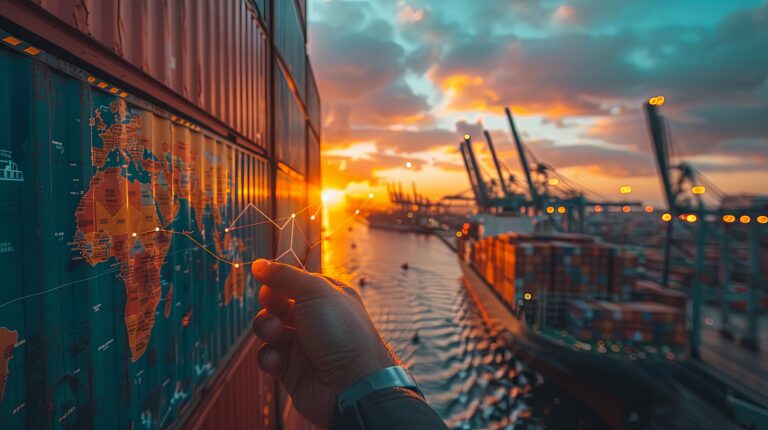Importance of ports as central transshipment points for global trade
Ports act as central hubs in the global trade network. In 2023, around 12 billion tons of goods were handled in ports worldwide, an increase of 2.4% compared to the previous year (UNCTAD). They are places where goods from different parts of the world come together for onward distribution. From container ships to bulk carriers to RoRo (roll-on/roll-off) ships, the variety of goods handled is enormous. The main tasks of ports include the loading and unloading of ships, the storage of goods, customs clearance and the forwarding of goods to their final destination.
The optimal handling of these processes is crucial for the punctuality and reliability of global supply chains. State-of-the-art technologies such as automation and digitalization are playing an increasingly important role in boosting productivity and accuracy in port operations. In 2023, around 50% of major container ports worldwide were using automation technologies to increase throughput (Journal of Port Technology). For example, autonomous cranes and transport vehicles are being used to optimize operations and increase throughput.
Economic importance of ports
The economic impact of ports extends far beyond their immediate surroundings. Regionally, ports are often the largest employers and attract numerous other industries and services. The port of Rotterdam generates around 30.6 billion euros in economic value added annually and creates around 193,000 direct and indirect jobs (Port of Rotterdam Authority). Ports act as engines of growth and create a large number of jobs in areas such as logistics, transportation, storage and administration.
On an international level, ports are indispensable hubs in global supply chains. They connect different modes of transport such as ships, trains, trucks and airplanes, ensuring the seamless transportation of goods over long distances. The efficiency of a port can have a direct impact on the cost and speed of international trade.
The economic importance of ports is clearly demonstrated by their role as central trading hubs. A significant proportion of global maritime trade is handled via some of the largest and strategically positioned ports such as Rotterdam, Antwerp and Hamburg. These ports are crucial for global trade routes and offer first-class connections to important inland transport networks. The port of Antwerp, for example, is the largest port in Belgium and one of the largest in Europe. The volume of container traffic in the port of Antwerp in 2023 was around 137.2 million tons. (Port of Antwerp Statistics)
Challenges and solutions for ports
Despite their central role in global trade, ports face numerous challenges. Infrastructure problems such as outdated facilities and limited capacity can lead to bottlenecks and delays. In addition, global trade is constantly increasing, putting pressure on existing infrastructure. Other challenges include safety concerns, environmental regulations and the need to adapt to technological change.
To overcome these challenges, ports are turning to various innovations and technologies. The automation of port operations, for example through the use of autonomous cranes and vehicles, can increase efficiency and reduce the error rate. By 2025, the majority of large container ports worldwide are expected to rely on fully automated systems. Digitalization and the use of big data enable better planning and control of port logistics. In addition, many ports are investing in the expansion of their infrastructure in order to meet increasing requirements.
Another example is the implementation of blockchain technologies to improve transparency and security in the supply chain. By using blockchain, all parties involved in a trade transaction – from the manufacturer to the end customer – can view the status and location of the goods at any time.
Sustainability in port logistics
Sustainability is an increasingly important topic in port logistics. Ports play a crucial role in reducing emissions and promoting environmentally friendly transportation solutions. Many ports have launched initiatives to minimize their environmental footprint. These include the use of shore power systems, which allow ships to switch off their engines in port and draw power from the shore grid instead, as well as the use of greener fuels and energy-efficient technologies.
Another example of sustainability initiatives is the promotion of intermodal transportation. By better integrating rail and inland waterway transport into port logistics, roads can be relieved and CO2 emissions reduced.
Conclusion: Ports as the key to global trade
In summary, it can be said that ports form the backbone of global trade. They are central transshipment points for goods and play a crucial role in international supply chains. Despite numerous challenges, ports are continuously working to increase their effectiveness and implement more sustainable solutions in order to continue to play a central role in global trade. The upcoming articles in this series will dive deeper into the specific examples of Europe’s largest ports and how they are adapting and evolving to meet the challenges of modern logistics.









